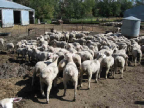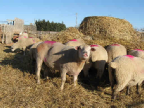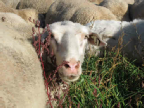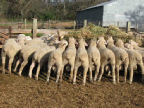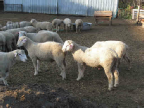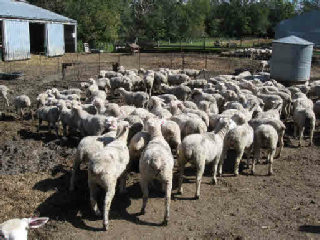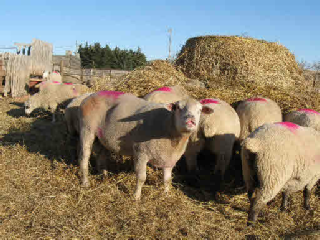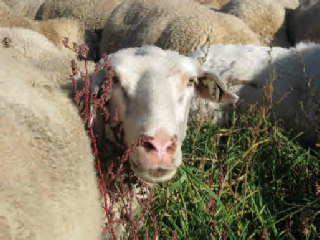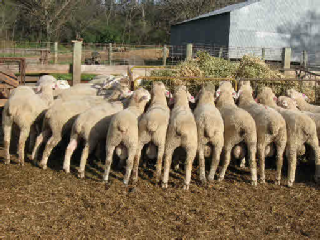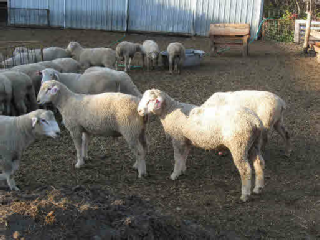



Copyright 2014 SIREMAX®
® All rights reserved. The owners of this website assert their right to restrict the use of the trademark SIREMAX® to sheep that have continually updated records in the SIREMAX® database and the LAMBPLAN database.
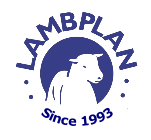










Planning for the Siremax project began in 1993, when 125 big-
In the summer of 1994, we weaned and weighed our first Siremax lamb crop. In the fall, we ultrasound scanned back fat and ribeyes, and weighed again. After all the lambs were ranked according to a lean-
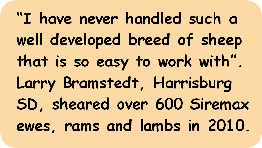 It didn’t take long to run out of unrelated Texel genetics. In 1996, we bought a composite ram from US MARC that was ½ Columbia, ¼ Suffolk, ¼ Hampshire. This breed mix fitted our goal of including all the primary US terminal breeds in our own composite, with the Texel to provide a source of genes for added muscle.
It didn’t take long to run out of unrelated Texel genetics. In 1996, we bought a composite ram from US MARC that was ½ Columbia, ¼ Suffolk, ¼ Hampshire. This breed mix fitted our goal of including all the primary US terminal breeds in our own composite, with the Texel to provide a source of genes for added muscle.
We went back to US MARC in 1997 and 1999 for more composite rams. Then in 2000 we bought a purebred Suffolk, and in 2001 we imported a Canadian Arcott. That breed is also a composite – primarily a mix of Suffolk and Ile de France.
Siremax has been a closed flock since 2001, and all the stud rams used after 2001 have come through our selection process. Some breeders scan a few of their lambs, some scan their stud rams. We weigh and scan every healthy lamb of known parentage. After the 2010 data analysis, there were over 5000 lamb records in the Siremax database.
WHAT DO WE DO?
What we do, and how we do it, can be summed up in one word:
LAMBPLAN
LAMBPLAN is a division of Sheep Genetics Australia. SGA is the national genetic evaluation service for the Australian sheep industry. Lambplan has processed all the data gathered from the Siremax project since 1994, when no entity in North America was available to analyze scanning data. Now Lambplan is doing the number crunching for the US National Sheep Improvement Program.
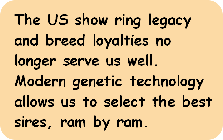 Like most US flocks, we lamb in April, which means breeding in November. However, our annual cycle begins in September, when we ultrasound scan and weigh all our lambs. The raw data are diligently prepared for analysis, including converting all the measurements into metric values, and converting our 4 and 5 digit ear tag numbers into 16 digit Lambplan-
Like most US flocks, we lamb in April, which means breeding in November. However, our annual cycle begins in September, when we ultrasound scan and weigh all our lambs. The raw data are diligently prepared for analysis, including converting all the measurements into metric values, and converting our 4 and 5 digit ear tag numbers into 16 digit Lambplan-
In early October we receive our analysis back from Lambplan, and we are able to identify the stud sires we will use within Siremax, the rams that we will offer to sell as terminal sires, and the ewe lambs that will be added to the Siremax flock.
We run 14 sire lines (14 separate genetic ‘families’), and we use stud rams from all 14 sire lines every year. So that we will know the parentage of every lamb, every ewe is assigned to a breeding group with one unrelated stud sire.
At lambing time, we upload information directly into an online lambing record that ultimately becomes part of a complete lambing, weaning, weighing, and scanning history of each lamb.
 We must also keep all production flocks genetically linked, so we exchange rams between the flocks every year. This allows us to combine the data from all the lambs, in all locations, into one annual data submission to Lambplan. It also allows us to compare, and rank, the performance of all these lambs, despite their having coming from different production environments.
We must also keep all production flocks genetically linked, so we exchange rams between the flocks every year. This allows us to combine the data from all the lambs, in all locations, into one annual data submission to Lambplan. It also allows us to compare, and rank, the performance of all these lambs, despite their having coming from different production environments.
MANAGEMENT
Apart from the gathering of raw data three times a year, and selection and breeding activities, Siremax sheep are managed as a commercial flock. Gestating ewes are out in blizzards, and lambs are out on pasture before and after weaning. When these pastures dry up performance may decline, and occasionally we lose lambs for all the usual reasons.
To identify genetically superior sheep, we know that we must provide sound nutrition and health care, so that every Siremax lamb has an equal opportunity to excel in a good commercial environment.
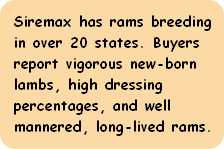 Unlike a commercial sheep operation, we do not benefit from carrying older ewes in the flock. We know they are more profitable to own, but the primary benefit in a Siremax flock lies in the improved genetic value of the youngest generation. So we use ram lambs as stud sires as much as possible, and retain as many ewe lambs as we can afford. The average age of the ewes in Siremax flocks is about 2.29 years.
Unlike a commercial sheep operation, we do not benefit from carrying older ewes in the flock. We know they are more profitable to own, but the primary benefit in a Siremax flock lies in the improved genetic value of the youngest generation. So we use ram lambs as stud sires as much as possible, and retain as many ewe lambs as we can afford. The average age of the ewes in Siremax flocks is about 2.29 years.
WHERE DO WE GO FROM HERE?
A small closed flock will become inbred over time despite the best management practices. The key to the future of an operation like Siremax is expansion, both in the number of ewes and in the number of flock owners. So in 2010 we found new locations for Siremax flocks in Montana and Oregon. They will act as franchisees of the Siremax project, developing their regional markets for superior terminal sires, while Siremax will continue to be responsible for project management and genetic development.
We are actively looking for locations for more franchise flocks. In the meantime we will consider setting up new Siremax flocks by upgrading. We will provide top Siremax rams to breeders who want to upgrade their own ewes. This is how Siremax began, except that the genetic progress will be much faster. Creating a Siremax flock this way will take a minimum of four generations, and upgrading flocks will comply with all Lambplan requirements and the Siremax Franchise Agreement.


Fall 2013 - the numbers:
Individual sheep records in the Lambplan Database:
Years scanning/opportunities for genetic improvement:
Outsourced sires used since 1993:
Siremax sires used since 1994:
Sire-
Single-
Siremax ewes exposed:
Average age of ewes exposed:
6847
20
19
135
14
21
590
2.57
